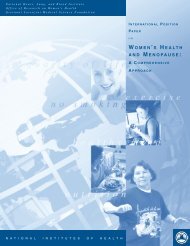HeartsNParks Community Mobilization Guide - National Heart, Lung ...
HeartsNParks Community Mobilization Guide - National Heart, Lung ...
HeartsNParks Community Mobilization Guide - National Heart, Lung ...
You also want an ePaper? Increase the reach of your titles
YUMPU automatically turns print PDFs into web optimized ePapers that Google loves.
foods low in saturated fat is the most effective<br />
dietary way to lower blood cholesterol levels,<br />
along with eating less total fat and cholesterol.<br />
Choose low-saturated fat foods such as<br />
grains, fruits, and vegetables; low-fat or skim<br />
milk and milk products; and lean cuts of<br />
meat, fish, and chicken. Trim fat from meat<br />
before cooking; bake or broil meat rather<br />
than fry; use less fat and oil; and take the<br />
skin off chicken and turkey. Reducing overweight<br />
will also help lower your level of<br />
LDL-cholesterol as well as increase your<br />
level of HDL-cholesterol.<br />
8 True. People who have had one heart attack<br />
are at much higher risk for a second attack.<br />
Reducing blood cholesterol levels can greatly<br />
slow down (and, in some people, even<br />
reverse) the buildup of cholesterol and fat in<br />
the walls of the arteries, and significantly<br />
reduce the chances of a second heart attack.<br />
9 True. Children from “high risk” families, in<br />
which a parent has high blood cholesterol<br />
(240 mg/dL or above), or in which a parent<br />
or grandparent has had heart disease at an<br />
early age (at 55 years or younger), should<br />
have their cholesterol levels tested. If a<br />
child from such a family has a cholesterol<br />
level that is high, it should be lowered under<br />
medical supervision, primarily with diet, to<br />
reduce the risk of developing heart disease<br />
as an adult. For most children, who are not<br />
from high-risk families, the best way to<br />
reduce the risk of adult heart disease is to<br />
follow a low-saturated fat, low cholesterol<br />
eating pattern. All children over the age of 2<br />
years and all adults should adopt a hearthealthy<br />
eating pattern as a principal way of<br />
reducing coronary heart disease.<br />
10 True. Heavy smokers are two to four times<br />
more likely to have a heart attack than<br />
nonsmokers, and the heart attack death rate<br />
among all smokers is 70 percent greater than<br />
that of nonsmokers. Older male smokers are<br />
also nearly twice as likely to die from stroke<br />
than older men who do not smoke, and these<br />
odds are nearly as high for older female<br />
smokers. Further, the risk of dying from<br />
NHLBI Health Information Center<br />
P.O. Box 30105, Bethesda, MD 20824-0105<br />
phone: (301) 592-8573 fax: (301) 592-8563<br />
lung cancer is 22 times higher for male<br />
smokers than male nonsmokers and 12 times<br />
higher for female smokers than female nonsmokers.<br />
Finally, 80 percent of all deaths<br />
from emphysema and bronchitis are directly<br />
due to smoking.<br />
11 True. One year after quitting, ex-smokers<br />
cut their extra risk for heart attack by about<br />
half or more, and eventually the risk will<br />
return to normal in healthy ex-smokers.<br />
Even if you have already had a heart attack,<br />
you can reduce your chances of a second<br />
attack if you quit smoking. Ex-smokers can<br />
also reduce their risk of stroke and cancer,<br />
improve blood flow and lung function, and<br />
help prevent diseases like emphysema and<br />
bronchitis from getting worse.<br />
12 False. Older smokers are more likely to<br />
succeed at quitting smoking than younger<br />
smokers. Quitting helps relieve smokingrelated<br />
symptoms like shortness of breath,<br />
coughing, and chest pain. Many quit to<br />
avoid further health problems and take<br />
control of their lives.<br />
13 True. Weight control is a question of balance.<br />
You get calories from the foods you eat. You<br />
burn off calories by exercising. Cutting<br />
down on calories, especially calories from<br />
fat, is key to losing weight. Combining this<br />
with a regular physical activity, like walking,<br />
cycling, jogging, or swimming, can not only<br />
help in losing weight but also in maintaining<br />
weight loss. A steady weight loss of 1/2 to 1<br />
pound a week is safe for most adults, and the<br />
weight is more likely to stay off over the<br />
long run. Losing weight, if you are overweight,<br />
may also reduce your blood pressure,<br />
lower your LDL-cholesterol, and raise your<br />
HDL-cholesterol. Being physically active<br />
and eating fewer calories will also help you<br />
control your weight if you quit smoking.<br />
14 True. Coronary heart disease is the number 1<br />
killer in the United States. Approximately<br />
489,000 Americans died of coronary heart<br />
disease in 1990, and approximately half of<br />
these deaths were women.<br />
High Blood Pressure 67
















